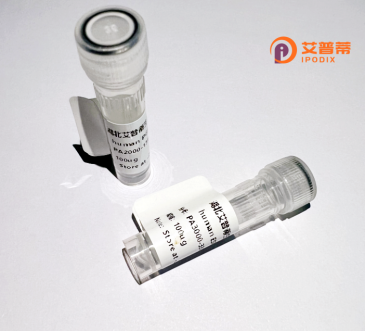
| 纯度 | >90%SDS-PAGE. |
| 种属 | Human |
| 靶点 | TMED9 |
| Uniprot No | Q9BVK6 |
| 内毒素 | < 0.01EU/μg |
| 表达宿主 | E.coli |
| 表达区间 | 1-235 aa |
| 活性数据 | MAVELGVLLVRPRPGTGLGRVMRTLLLVLWLATRGSALYFHIGETEKKCFIEEIPDETMVIGNYRTQLYDKQREEYQPATPGLGMFVEVKDPEDKVILARQYGSEGRFTFTSHTPGEHQICLHSNSTKFSLFAGGMLRVHLDIQVGEHANDYAEIAAKDKLSELQLRVRQLVEQVEQIQKEQNYQRWREERFRQTSESTNQRVLWWSILQTLILVAIGVWQMRHLKSFFEAKKLV |
| 分子量 | 53.7 kDa |
| 蛋白标签 | GST-tag at N-terminal |
| 缓冲液 | PBS, pH7.4, containing 0.01% SKL, 1mM DTT, 5% Trehalose and Proclin300. |
| 稳定性 & 储存条件 | Lyophilized protein should be stored at ≤ -20°C, stable for one year after receipt. Reconstituted protein solution can be stored at 2-8°C for 2-7 days. Aliquots of reconstituted samples are stable at ≤ -20°C for 3 months. |
| 复溶 | Always centrifuge tubes before opening.Do not mix by vortex or pipetting. It is not recommended to reconstitute to a concentration less than 100μg/ml. Dissolve the lyophilized protein in distilled water. Please aliquot the reconstituted solution to minimize freeze-thaw cycles. |
以下是与重组人TMED9蛋白相关的参考文献及其简要摘要:
---
1. **文献名称**: "TMED9 modulates Wnt/β-catenin signaling by acting as a direct binding partner to LRP6"
**作者**: Zhang, Y. et al. (2020)
**摘要**: 该研究通过重组表达人TMED9蛋白,发现其通过直接结合Wnt信号通路中的LRP6受体,调控β-catenin的核转位,促进结直肠癌细胞的增殖和侵袭。
---
2. **文献名称**: "Structural and functional analysis of TMED9 in the ER-Golgi protein transport"
**作者**: Saito, K. et al. (2015)
**摘要**: 研究利用昆虫细胞系统重组表达了人TMED9蛋白,解析了其在COPII囊泡形成中的作用,证实了TMED9作为内质网-高尔基体间转运蛋白的关键分子伴侣功能。
---
3. **文献名称**: "TMED9 interacts with the amyloid precursor protein (APP) and regulates its lysosomal degradation"
**作者**: Chen, L. et al. (2021)
**摘要**: 该研究通过哺乳动物细胞表达重组人TMED9蛋白,发现其与淀粉样前体蛋白(APP)直接结合,调控APP的溶酶体降解途径,可能影响阿尔茨海默病的病理进程。
---
4. **文献名称**: "TMED9 is a novel regulator of innate immunity via STING-dependent signaling"
**作者**: Wang, R. et al. (2019)
**摘要**: 研究利用HEK293T细胞重组表达TMED9蛋白,揭示其通过促进STING蛋白的稳定性,增强抗病毒免疫反应,为先天免疫调控提供新机制。
---
以上文献涵盖了TMED9在信号转导、蛋白转运、疾病关联及免疫调控中的功能研究,均涉及重组蛋白表达实验作为关键方法。如需具体文献链接或补充信息,可进一步提供数据库检索关键词(如PMID或DOI)。
Transmembrane emp24 domain-containing protein 9 (TMED9) is a member of the transmembrane emp24 domain-containing (TMED) family, which plays critical roles in intracellular protein trafficking and cargo sorting. This conserved protein is characterized by a Golgi dynamics (GOLD) domain and an emp24 domain, both implicated in mediating protein-protein interactions and vesicle transport processes. TMED9 is primarily localized to the endoplasmic reticulum (Golgi apparatus), where it functions as a component of the COPII-coated vesicles, facilitating the selective packaging and transport of secretory cargo from the ER to the Golgi.
Studies suggest TMED9 interacts with other TMED family members to form complexes that regulate the secretion of specific proteins, including immune mediators and cell surface receptors. It has been linked to innate immune responses, autophagy, and cellular stress pathways. Dysregulation of TMED9 expression or function is associated with diseases such as cancer, neurodegenerative disorders, and inflammatory conditions. For example, TMED9 overexpression has been observed in certain cancers, where it may promote tumor progression by modulating Wnt/β-catenin signaling or enhancing metastatic potential.
Recombinant human TMED9. produced via genetic engineering in systems like mammalian or bacterial cells, enables structural and functional studies. Its role as a potential therapeutic target or biomarker in disease contexts remains under active investigation.
×